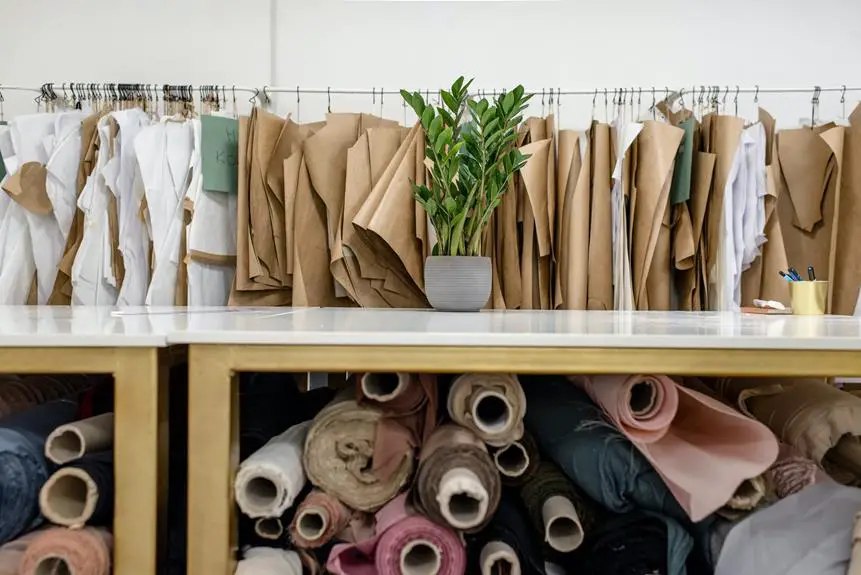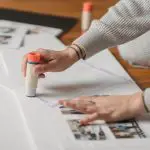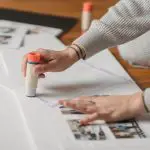Do you ever wonder if Gorilla Glue can work its magic on fabric like it does on other materials? Understanding the potential of Gorilla Glue with fabric can open up a world of possibilities for your projects.
From understanding the composition of Gorilla Glue to mastering the application techniques, you'll find that achieving a strong bond on fabric is indeed possible.
By delving into the types of fabric compatible with Gorilla Glue and the factors influencing adhesion, you can confidently tackle any fabric-related bonding challenge.
This brief exploration will equip you with the knowledge and skills needed to harness the adhesive power of Gorilla Glue for your fabric projects.
Key Takeaways
- Gorilla Glue is a polyurethane-based adhesive that forms strong bonds with fabric.
- Cotton, denim, canvas, and fleece are fabric types that are compatible with Gorilla Glue.
- Proper fabric surface cleaning is essential for optimal adhesion when bonding with Gorilla Glue.
- Applying Gorilla Glue evenly, following the manufacturer's instructions, and applying consistent pressure will result in a strong and durable bond between Gorilla Glue and fabric.
Understanding Gorilla Glue and Its Composition
Understanding Gorilla Glue and Its Composition involves examining the adhesive's ingredients and their interactions with various surfaces. The adhesion mechanisms of Gorilla Glue are key to understanding its effectiveness.
This polyurethane-based adhesive forms strong bonds by creating a chemical reaction with moisture. When applied to surfaces, the glue expands and penetrates the material, creating a powerful bond. Additionally, Gorilla Glue offers excellent chemical compatibility with a wide range of materials, making it suitable for various bonding applications.
When it comes to fabric bonding techniques, Gorilla Glue can be used to effectively bond different types of fabrics. Understanding the composition of the glue and its interaction with fabrics is crucial for achieving optimal results. The strength of the bond can be tested using various methods such as tensile strength testing, where the bonded fabric is subjected to tension to evaluate the durability of the bond.
This thorough understanding of Gorilla Glue and its composition empowers you to utilize this adhesive effectively for fabric bonding, ensuring strong and reliable results.
Types of Fabric Compatible With Gorilla Glue
To effectively bond fabric with Gorilla Glue, you need to consider the types of fabrics that are compatible with this adhesive. Gorilla Glue is a versatile adhesive that can form strong bonds with various fabric types, but some fabrics adhere better than others. When choosing a fabric to work with Gorilla Glue, consider the following fabric compatibility and adhesion factors:
- Cotton: Gorilla Glue adheres well to cotton fabric, making it suitable for a wide range of projects, including fabric repairs and crafting.
- Denim: The rough texture of denim provides an excellent surface for Gorilla Glue to adhere to, allowing for durable and long-lasting bonds.
- Canvas: Gorilla Glue is compatible with canvas fabric, making it suitable for heavy-duty fabric applications such as repairing outdoor gear and creating fabric-based crafts.
- Fleece: Fleece fabric is also compatible with Gorilla Glue, enabling strong adhesion for projects involving fleece material.
Preparation Techniques for Fabric Bonding
Before bonding fabric with Gorilla Glue, it's crucial to ensure the fabric surface is clean and free from any dirt, dust, or debris. Proper application of the glue is essential, and you'll want to ensure you apply an even layer to the fabric for a strong bond.
Additionally, using clamps to apply pressure while the glue sets will help achieve a secure and durable bond.
Fabric Surface Cleaning
To properly prepare fabric for bonding with Gorilla Glue, begin by thoroughly cleaning the surface. Follow these steps to ensure the fabric is ready for bonding:
- Identify the Stain: Determine the type of stain on the fabric, as different stains may require different cleaning methods.
- Spot Test: Before applying any cleaning solution, perform a spot test on a small, inconspicuous area of the fabric to ensure it won't cause damage or discoloration.
- Choose the Right Cleaning Method: Depending on the fabric type and the nature of the stain, select an appropriate cleaning method such as dry cleaning, gentle hand washing, or using a specific fabric cleaner.
- Allow for Drying Time: After cleaning, allow the fabric to thoroughly dry before attempting to bond it with Gorilla Glue to ensure proper adhesion.
Following these steps will help ensure the fabric is clean and ready for bonding with Gorilla Glue.
Proper Glue Application
You frequently need to ensure that the fabric is clean and thoroughly dried before applying Gorilla Glue for bonding. Proper drying is crucial to achieving maximum adhesion strength when working with fabric.
Begin by washing the fabric with mild detergent and water, then allowing it to air dry completely. Avoid using fabric softeners or dryer sheets as they can leave a residue that inhibits the glue's ability to bond.
Once the fabric is dry, lay it flat on a clean, smooth surface and apply the Gorilla Glue evenly to one of the surfaces being bonded. Be sure to follow the manufacturer's instructions for the specific type of Gorilla Glue being used.
When bonding fabrics, applying consistent pressure to the bonded area for the recommended time will help ensure a strong, durable bond.
Clamping for Pressure
For optimal fabric bonding with Gorilla Glue, ensure you apply consistent pressure by using clamps during the bonding process. Proper clamping techniques are crucial for even pressure distribution, which is essential for achieving strong fabric adhesion and maximizing bonding strength.
Follow these steps to master the art of clamping for pressure:
- Select the Right Clamp: Choose clamps that are suitable for fabric bonding, such as C-clamps or bar clamps.
- Even Pressure: Position the clamps evenly across the fabric to distribute pressure uniformly.
- Avoid Over-Tightening: Apply enough pressure to ensure a secure bond, but avoid over-tightening, which may damage the fabric.
- Allow Sufficient Drying Time: Keep the fabric clamped for the recommended drying period to allow the Gorilla Glue to cure properly.
Application Methods for Gorilla Glue on Fabric
Achieve optimal adhesion by applying Gorilla Glue directly to the fabric using a thin, even layer. Start by preparing the fabric, ensuring it's clean and dry. Lay the fabric on a flat surface, and using a brush or a small spatula, apply a small amount of Gorilla Glue onto the fabric. Spread the glue evenly over the surface, ensuring that the entire area to be adhered is covered. Avoid using too much glue, as excess adhesive can lead to a messy application and longer curing times.
Once the glue is applied, firmly press the fabric onto the other surface to be bonded. Apply pressure evenly across the entire surface to ensure a strong bond. If necessary, use clamps or heavy objects to hold the fabric in place while the glue sets. Allow the adhesive to cure according to the manufacturer's instructions.
Remember to work quickly and efficiently, as Gorilla Glue sets rapidly. When done correctly, this application method will result in a strong and durable bond, ensuring that the fabric remains securely adhered.
Factors Affecting Adhesion to Fabric
When it comes to the adhesion of Gorilla Glue to fabric, several crucial factors can influence the outcome.
The type and texture of the fabric, surface preparation techniques, and the application and drying time all play significant roles.
Understanding how these points affect adhesion will help you achieve the best results when using Gorilla Glue on fabric.
Fabric Type and Texture
How can Gorilla Glue adhere to different types and textures of fabric? The adhesion of Gorilla Glue to fabric is influenced by several factors, including fabric type and texture. Here are the key factors affecting adhesion to fabric:
- Fabric Type: Different types of fabric, such as cotton, polyester, nylon, and wool, have varying levels of absorbency and smoothness, which can impact how well Gorilla Glue adheres.
- Fabric Texture: The texture of the fabric, whether it's smooth, rough, or textured, can affect the surface area available for the glue to bond, ultimately influencing the strength of the adhesion.
- Fabric Durability and Maintenance: The durability and maintenance of the fabric can determine how well it withstands the bonding process and the long-term adhesion.
- Fabric Dyeing and Printing: Dyed or printed fabrics may have different chemical compositions on their surfaces, which can affect the interaction with Gorilla Glue and the resulting adhesion.
Surface Preparation Techniques
To ensure successful adhesion of Gorilla Glue to fabric, begin by carefully preparing the fabric surface. Proper surface preparation is crucial for achieving strong and durable fabric adhesion.
Firstly, clean the fabric thoroughly to remove any dirt, dust, or oils that could hinder the glue's ability to bond. Use a mild detergent and water to gently wash the fabric, ensuring it's completely dry before applying the glue.
Next, consider roughening the fabric's surface slightly using sandpaper or a wire brush to create a better bonding surface for the glue.
Additionally, if the fabric is particularly smooth or has a water-resistant coating, consider using a fabric primer to enhance adhesion.
Following these surface preparation techniques will significantly improve the adhesion of Gorilla Glue to fabric, ensuring a reliable and long-lasting bond.
Application and Drying Time
After preparing the fabric surface, you'll proceed with the application of Gorilla Glue and consider the drying time, which are crucial factors affecting its adhesion to fabric. Follow these steps for optimal results:
- Application Techniques: Apply Gorilla Glue evenly on the fabric, ensuring that the entire surface is covered. Consider using a small brush or a cotton swab for precise application.
- Even Pressure: After applying the glue, use even pressure to bond the fabric together. This will ensure that the adhesive penetrates the fibers for a strong bond.
- Drying Process: Allow the glued fabric to dry for at least 1-2 hours. Ensure that the glued fabric is placed in a well-ventilated area with moderate temperature and low humidity for optimal drying.
- Curing Time: For maximum adhesion, let the fabric cure for 24 hours before subjecting it to any stress or strain.
Projects and Repairs Using Gorilla Glue on Fabric
When using Gorilla Glue on fabric, you'll want to ensure that the surface is clean and dry before applying the adhesive. Whether you're working on outdoor gear repairs or creating DIY fashion accessories, Gorilla Glue can be a reliable solution for bonding fabric. Here's a handy guide to help you tackle your fabric projects and repairs effectively.
| Project/Repair | Gorilla Glue Type |
|---|---|
| Outdoor Gear Repairs | Gorilla Super Glue Gel |
| DIY Fashion Accessories | Gorilla Fabric Glue |
| Tent and Tarp Patching | Gorilla Waterproof Patch & Seal Tape |
| Hemming or Patching Jeans | Gorilla Super Glue |
| Canvas Bag Repairs | Gorilla Clear Repair |
For outdoor gear repairs, Gorilla Super Glue Gel offers a strong and fast adhesive solution. When working on DIY fashion accessories, Gorilla Fabric Glue provides a durable bond suitable for various fabric types. Need to patch a tent or tarp? Consider using Gorilla Waterproof Patch & Seal Tape for a reliable, long-lasting repair. For quick fixes like hemming or patching jeans, Gorilla Super Glue is a versatile option. When it comes to canvas bag repairs, Gorilla Clear Repair offers a transparent, heavy-duty bond. Always follow the product instructions for best results.
Tips for Achieving Strong Fabric Adhesion With Gorilla Glue
To achieve strong fabric adhesion with Gorilla Glue, start by carefully following the application instructions provided on the product packaging. When working on fabric bonding projects, consider the following tips for maximizing adhesive strength:
- Surface Preparation: Ensure that the fabric is clean and free of any dust, dirt, or debris. For best results, consider washing and thoroughly drying the fabric before applying the Gorilla Glue.
- Appropriate Amount of Glue: Apply a thin, even layer of Gorilla Glue to the fabric. Using too much glue can lead to a messy application and may not necessarily result in stronger adhesion.
- Clamping or Pressing: Once the glue is applied, firmly press the fabric together to ensure maximum contact between the adhesive and the fabric. Consider using clamps or heavy objects to apply even pressure across the bonded area.
- Drying Time and Conditions: Allow sufficient time for the Gorilla Glue to cure. Follow the recommended drying time provided on the product packaging and ensure that the fabric is kept in a well-ventilated area during the drying process.
Frequently Asked Questions
Can Gorilla Glue Be Used on Delicate or Sheer Fabrics?
For delicate or sheer fabrics, silk bonding and bonding techniques are crucial. When using Gorilla Glue on such materials, ensure precision and care to avoid any damage. Gorilla Glue can be effective, but it requires finesse.
Will Gorilla Glue Bond to Waterproof or Water-Resistant Fabrics?
Gorilla Glue is not the best option for bonding to waterproof or water-resistant fabrics. Instead, consider using specialized fabric glues designed for these materials. They offer better adhesion and are tailored for these specific uses.
Is It Safe to Wash Fabric Bonded With Gorilla Glue in a Washing Machine?
To ensure fabric care and washing machine safety, follow these fabric bonding washing instructions. Check the label for specific washing instructions and avoid machine washing if not recommended. Always prioritize fabric care and proper washing instructions.
Can Gorilla Glue Be Used to Repair Outdoor Fabric Items Like Tents or Awnings?
When repairing outdoor gear, it's essential to choose the right adhesive. Gorilla Glue is great for fabric crafting and provides a strong bond for outdoor fabric items like tents or awnings. If you need alternatives, consider fabric-specific adhesives.
How Long Does Gorilla Glue Take to Fully Cure on Fabric?
Fabric bonding with Gorilla Glue can take up to 24 hours to fully cure. When using fabric glue, ensure the material is clean and dry, apply a thin layer, and clamp the pieces together for optimal adherence.
- Why Guipure Lace Offers More Structure Than Softer Laces - June 25, 2025
- Choosing Your Lace: The Pros and Cons of Guipure Fabric - June 25, 2025
- A Visual Guide: Identifying Guipure Lace From Other Lace Types - June 25, 2025







